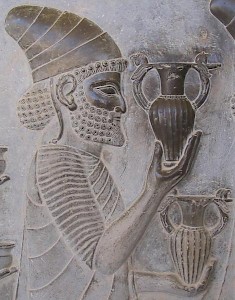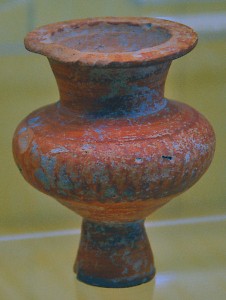Lydia (satrapy)
Q3832039Lydia: satrapy in the Achaemenid Empire. Its capital was Sardes.

After he had subjected the Lydian Empire, Cyrus appointed a man named Tabalus as governor, but the Lydians immediately revolted. However, the insurrection was quickly suppressed by general Mazares and his successor Harpagus. From now on, Lydia was known as the Persian satrapy (province) Sparda and governed by a viceroy or satrap. The new rulers improved the route that connected Sardes, Gordium and the capitals of Persia (Susa, Persepolis, Pasargadae), which became known as the Royal road.
We do not know how long Harpagus was ruler of western Anatolia, but it may have been quite a long time, because a local dynasty in Lycia claimed to descend from Harpagus, and often, these claims have turned out to be correct. Whatever the truth, when Cyrus died fifteen years later, the satrap of Lydia had been replaced by a man named Oroetus.
During the reign of Cambyses (530-522), Oroetus took care of Lydia, and during the chaotic period after the king's death, he conquered the Greek isle of Samos, killing its ruler Polycrates, an ally of Egypt and enemy of Persia. Oroetus may simply have done his duty, but as it turned out, he now owned the gold of Lydia and the navy of Samos, and was suddenly very powerful - too powerful for the new king Darius the Great (522-486). A man named Bagaeus made sure that Oroetus was killed and may briefly have been satrap; in any case, the next rulers in Sardes were Otanes (who restored order in Samos in 517) and Darius' younger brother Artaphernes (after 513).
In the first decade of the fifth century, Lydia was a frontier area, because the Greeks on the Asian west coast -or Yaunâ, as the Persians called them- revolted in 499 and sacked the lower city of Sardes. They held out for five years but the resurrection was eventually suppressed. Artaphernes surprised the Greek world by his lenient treatment of the defeated rebels, although it seems that rich Persian landlords took over many country estates.
From now on, many Iranians were living in Lydia, and we find indications for the worship of eastern gods (e.g., Anahita) and "persification" of Lydian deities. For example, the priest Artimus/Artemis at Ephesus became known as the megabyxus, "the one set free for the cult of the divinity", and the god Pldans (the Greek Apollo) was identified with Ahuramazda.

Sometimes, estates were given to loyal Greeks; on other sites, we find Iranian garrisons, like Hyrcanians in the valleys of the Caicus and Hermus. During the fifth century, the Lydians increasingly lost control of their country.
Artaphernes was succeeded in 492 by his son, also called Artaphernes, who is known to have served, together with Datis, as one of the commanders of the Persian expeditionary force that captured Eretria but was defeated by the Athenians at Marathon (490). Ten years later, the younger Artaphernes commanded the Lydians and Mysians when Darius' son Xerxes invaded Greece. The great king had to return before he had fully reached his goals, and Greece remained independent. Artaphernes must have seen how the Athenians liberated the Greek cities on the west Asian west coast in 479, but he is conspicuously absent from the written sources. Maybe, his troops were needed in Babylonia.
| Tabalus |
|
| Mazares |
|
| Harpagus |
|
| Oroetus |
|
| Bagaeus |
|
| Otanes |
|
| Artaphernes I |
|
| Artaphernes II |
|
In fact, we hardly know anything about Lydia in the four decades after 480, because most sources are in Greek and focused on the history of Athens, which had not much to do with Lydia after it had created a cordon sanitaire of Greek cities in Asia. It is only in 440 that Lydia returns to our sources, when the satrap Pissuthnes tried to reconquer Samos, which had revolted against Athens. It came to nothing. When Athens was involved in the Archidamian War against Sparta (431-421), Pissuthnes tried to expand his influence among the Yaunâ by supporting almost every rebel in the Athenian empire (e.g., Colophon, Lesbos).
In 420, Pissuthnes revolted against king Darius II Nothus. We do not know why. The king sent a nobleman named Tissaphernes to Lydia, who arrested, executed, and succeeded to the satrap of Lydia in ca.415. During his first years, he still had to fight against Pissuthnes' son Amorges, who continued the struggle with -perhaps surprisingly- help from Athens. It was probably this Athenian intervention that made king Darius side with Sparta in the Decelean or Ionian War (413-404). To facilitate negotiations, Darius sent his younger son Cyrus; Tissaphernes, although demoted, remained loyal, and was able to regain his position when Cyrus had unsuccessfully revolted.
By now, Sparta had defeated Athens, and as leader of the Greek world, it felt it had to intervene in Asia. Tissaphernes overcame the invasion of Thibron (399), but was defeated at Sardes by the Spartan king Agesilaus. The satrap was executed and replaced by Tiribazus, who restored order in Lydia and was responsible for the first of a series of treaties between the Persian king and the Greek city states, the King's Peace of 387/386.
The next satrap we know of is Autophradates, who was the great king's loyal supporter during the series of revolts that was started in 370 by Datames of Cappadocia, and continued by Ariobarzanes of Hellespontine Phrygia and Orontes of Mysia between 367 and 360. Autophradates was probably Tiribazus' direct successor, but if he is identical to the Autophradates who is mentioned as a naval commander in the 330s, we must probably insert a satrap between Tiribazus and Autophradates.
| Pissuthnes |
|
| Tissaphernes |
|
| Cyrus the Younger |
|
| Tissaphernes |
|
| Tiribazus |
|
| Autophradates |
|
| Spithridates |
|

The last satrap of Lydia was Spithridates, who was killed by the Macedonian conqueror Alexander the Great in the battle at the Granicus (spring 334). In the early summer, Sardes surrendered. From now on Lydia was to be ruled by Greek-speaking governors, first as part of the empire of Alexander, then controlled by Antigonus Monophthalmus, after 301 by Lysimachus, from 281 to 190 as province of the Seleucid Empire. Often, they did direct business with the cities, and as an administrative unit, Lydia became obsolete.
Again, many settlers moved to the old country. King Seleucus I Nicator, the first ruler of the empire that is named after him, founded Thyatira, his son Antiochus I Soter founded Stratonicea, and Antiochus III the Great resettled 2,000 Jewish families from Babylonia in Lydia. The Greek language spread across the country, many buildings were rebuilt according to Greek archaeological designs, and many towns invented myths to prove they had been founded by Greek heroes like Heracles or warriors from the Trojan War.
When the Romans had defeated the Seleucid king Antiochus III, they first gave Lydia to their ally, the kingdom of Pergamon, and added it to their own empire in 133. From now on, Lydia was officially known as the Roman province of Asia.